Everything you need to know about a Sunny side up delivery, related complications and turning your sunny side up baby.
-
Author: Khushboo Kirale
- >> Post Created: February 25, 2022
- >> Last Updated: May 2, 2024
Medically Reviewed by: Dr. Veena Shinde (M.D, D.G.O, PG – Assisted Reproductive Technology (ART) from Warick, UK) Mumbai, India
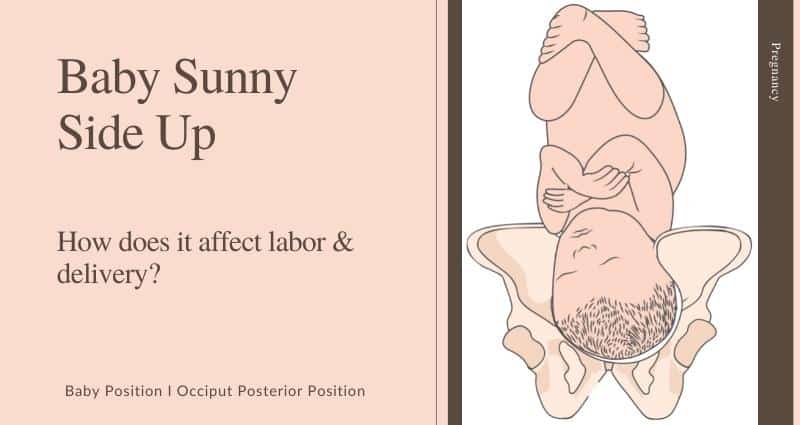
Table of Contents
‘Sunny side up!’ brings about happy, warm feelings, doesn’t it? Thanks to its association with positive scenes.
However, if you hear your doctor say your – ‘baby sunny side up’ or you have a ‘Occiput Posterior baby’ then it may not be such great news as a sunny side up baby generally is associated with prolonged labor, perineal tearing and induction.
Having an Occiput posterior baby/ baby sunny side up may happen to merely 5-8% of deliveries. And if you do fall in this rare category, then too there are quite a few things you can do to prepare yourself and maybe even dodge a sunny side up delivery altogether by doing simple exercises to change your baby’s position from being a posterior baby to anterior baby.
This write-up aims to explain what a Baby sunny side up is and means, the sunny side up delivery complications & risks and the possible ways to turn the sunny side up baby for a comparatively easier childbirth experience.
What does it mean when your doctor says you have a ‘baby sunny side up’?
A baby sunny side up or a occiput posterior baby – is referred to as when the baby is positioned head down – facing mothers belly. This position is kind of opposite to having an Occiput Anterior baby position.
It means the baby’s back is against the mother’s back and facing the mothers belly – medically it is also referred to as an Occiput Posterior Position (OP).
In a vaginal delivery, the baby will enter this world with its face up and hence the term, sunny side up baby or baby sunny side up.
Various Occiput Posterior Position: Right Occiput Posterior (ROP baby position) and Left Occiput Posterior (LOP baby position)
As mentioned above, in an occiput posterior position, the baby is head-down, back against mother’s back and facing the mother’s abdomen. Now if your baby is a occiput posterior baby, but slightly angled and facing to the left; i.e. facing the mother’s right hip, then it is Left Occiput Posterior position (LOP baby position).
Similarly, if the baby is slightly angled toward the right side facing the mother’s left hip, then it is referred to as Right Occiput Posterior position (ROP baby position).
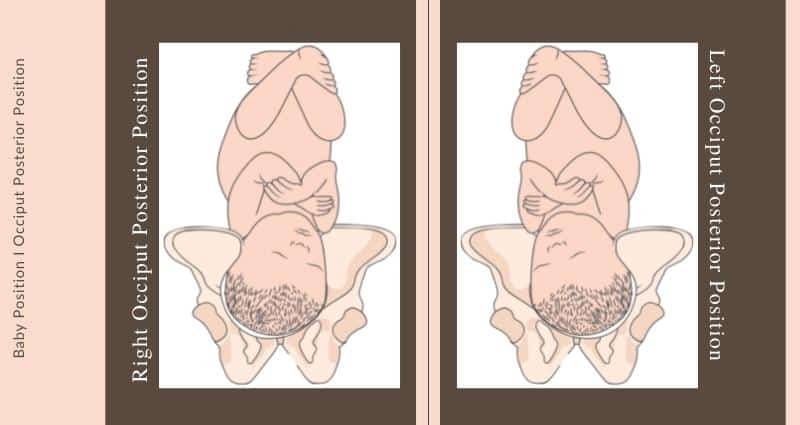
How to know if you have a occiput posterior baby position – baby sunny side up?
It is only after 34 weeks into pregnancy that a medical professional may be able to tell the position of the baby by feeling your belly with their hands. More experienced practitioners can also tell you if you have a posterior baby/ baby sunny side up by your baby’s palpitations only.
Here are a few posterior baby signs that you can check for on your own-
- Consistent lower back pain
- Little flutters (possibly the baby’s fingers) on your belly just above the pubic bone
- Feeling firm kicks to your ribs
- No baby butt by the ribcage
- Pressure on the sacrum
- Failure to engage into the birth canal
There is also a something called as belly mapping, which uses a combination of fetal movement tracking, along with non-toxic body paint and a heart monitor (not compulsory). However, this may not work in the best way if you have an anterior placenta or excessive amniotic fluid.
Besides this, know that an Ultrasound Scan is the most accurate method to determine the position of your baby in the womb.
Fears of baby sunny side up or posterior baby position
A baby sunny side up position/ Posterior fetal position – be it left occiput posterior or right occiput posterior, makes the labor process slower and painful (also referred to as ‘back labor’).
This is because in the sunny side up baby position, the baby’s back is along the mother’s back and his/her chin slightly lifted, which makes the head seem larger when the baby enters the pelvic region.
Having a posterior baby is not a concern until labor, but when it begins, the full circumference of the baby’s head tries to enter the narrow pelvic opening causing the mother a lot of pain and delay in the baby’s birth.
But before you start sweating about it, there are still good chances that you have a successful vaginal delivery despite having a sunny side up baby. Also, many posterior babies naturally shift into the desired anterior position before labor. There are some methods that can help with this, which we will discuss ahead.
What causes a baby to take up a posterior position/ baby sunny side up position?
As you have understood a posterior position is not the best for labor and delivery. Medical experts may have conjectured a few motivations as to what makes a baby settle in a posterior position, but the exact reasons are undetermined. Here’s what they believe can cause a baby sunny side up position –
- Poor posture and/or desk jobs can be one of the major reasons for sunny side up baby. If the mother has a poor posture or her feet are frequently elevated, then it leaves less space for the baby to move in to the best birthing position.
- Having a breech baby in the later stages of your pregnancy i.e. your 3rd trimester
- Low thyroid issues in mother
- Poor hip alignment possibly due to genetic reasons, or from a desk job, or an injury. reasons
- Having an Anterior placenta could sometimes cause a baby to be in an occiput posterior position
- Epidural, the numbing medicine given, may also have a role to play in the baby taking up a posterior position. Some studies have shown a correlation however experts have to learn more in this region.
Read this next
Sunny side up baby complications
Baby sunny side up/ occiput posterior baby is not the usual or optimal birth position for the baby, therefore it does have its set of complications. The posterior baby position puts the baby’s head in a spot where it is prone to be obstructed by the mother’s pubic bone. With this, the mother feels pressure on her spine and sacrum.
However, be assured that in the occiput posterior position, your baby will not necessarily get stuck during childbirth. Your experience during labor and childbirth depends quite a bit on the narrowness of your hips, your baby’s head circumference and the exact position of the baby.
Nevertheless, with posterior fetal position, there are possibilities of the following complications:
- Water breaking prematurely: There are chances that the baby’s posterior position may break one of the amniotic bags prematurely, which in turn will force the doctors to get the baby out before the due date.
- Back labor: A sunny side up baby results in more pain in the back than the abdomen during labor.
- Lengthy labor & delivery time: There can be many reasons for this; posterior baby may break one of the amniotic bags prematurely due to which the doctor may have to induce labor for childbirth or the baby’s head might not fit in well in the pelvic inlet or the cervix may take more time to dilate.
- Start & stop labor pattern (prodromal labor): This happens while the baby is sunny side up as your body is not happy and comfortable with labor in this position. A prodromal labor is generally painful & exhausting.
- Severe perineal tearing or cervical injury: The former is common, while the later isn’t. Perineal tears are a result of the baby putting extreme pressure to your back, which in turn will signal the body to push even before the cervix has dilated completely.
- Less participation from the baby when the mother is in the pushing stage of delivery
- Higher possibility for the need of C-section
- Longer neonatal stay in hospital
- Higher chances of need for assisted delivery (use of vacuum or forceps)
If the labor puts great strain on the baby or the mother, then doctors may take a decision for assisted delivery or C-section.
Even if you are nearing your due date and your baby is still in the occiput posterior position, then we continue to emphasize that you try to remain calm and do not give in to panic. That can only make matters worse. Instead, discuss your situation in detail with your doctor and together agree to whatever procedure suits you.
What are the chances you will have a baby sunny side up?
We have already discussed what can be some of the causes that may increase the possibility of having a sunny side up baby. Apart from that, it is important to know that a woman’s anatomical structure too has a significant role to play, along with her posture (yes, something as slight as this) and her level of activity in everyday life.
Women who are conceiving for the first time and the ones who have an android pelvis – narrow pelvic canal – have higher chances of a sunny side up baby. As taller women are more likely to have an android pelvis, with a triangular or heart-shaped inlet, the delivery of the baby might pose some difficulty, as they have to push harder during childbirth.
Right posture of the mother is also a significant factor when it comes to the baby’s position before labor. Activity too is necessary, as proper alignment of hips and pelvic joints while moving will encourage the baby to move into the optimal birthing position.
How can I avoid the baby sunny side up fetal position?
There are a few activities and exercises you can do to prevent your baby going into the posterior position in labor. However, if you are a first-time mother, you should begin these at least 6 weeks before your due date and 3-4 weeks before due date if you have already delivered before. If you have come across this article a little late in your pregnancy, then too start doing them.
The good thing about these are that you can do these even if you don’t know the exact position of your baby, because it will not change an anterior baby’s position.
- Stay active. Walk as much as possible, but don’t overstrain yourself
- Shun all reclining positions. And if you are tempted to sit on a soft, reclining seat, then put a pillow under your butt and sit with your pelvis forward.
- Try to stay in positions where your knees are below the pelvis and your back is straight. A big birth ball is the perfect place to sit on for this position. Office chairs with knee rests might also work. You have to aim at keeping the pelvic region tilted forward all the time.
- Perform pelvic rocks on your hands & knees for at least 20 mins, three times a day. Also exercise some poses like the playful puppy pose – chest to the floor and buttocks up in air.
- This next method will not only help you in pregnancy, but also ensure your house is clean. Get on your knees and wipe the floor. Moving around this way is great to get the baby in the anterior position.
- Try to sleep on your left side, keeping the left leg straight and right leg at 90-degree angle supported by pillow/s. This position creates a ‘hammock’ for the baby, motivating it to rotate.
- Lie down on your back, supporting your lower back with a rolled towel, such that you form an exaggerated arch. This will enable posterior babies to turn by hyperextending their necks.
- If you are sure about the baby’s position and have an idea about the location of its hands and knees, then you can gently massage your baby to guide it in the desired position. It is preferable that you first learn this in the presence of a midwife or doctor.
- Avoid squatting if you are not completely sure if the baby is in the anterior position. Squatting can sometimes force a posterior baby in the pelvis, reducing the chances of it turning into anterior position.
- Homeopathic pulsatilla is said to help even out muscles in the uterus, permitting the baby to fit into the best position.
- Sometimes the reason a baby is posterior is because the mother’s lower stock muscles are weak. If so is the case, then a belly binding (belly support) – a large sheet or towel wrapped tightly around you belly for support – could help.
- If the umbilical cord is not allowing the baby to turn, then try using methods to rotate the baby I the opposite direction to unwrap the cord and then turn it to the desired position. To do so, try sleeping on the right side, instead of left.
Some methods are psychological, but believed to be helpful –
- Picture an anterior baby, preferably a left occiput anterior (LOA) baby, with the baby’s buttocks towards the belly, but a little toward the left of the belly button.
- Talk to your baby, yes, to your unborn child! J Tell him/her to anterior or a position that will make it easy for it to come out in this world
- Relax in a warm bathtub or in a nice comfy place and have a heart-to-heart conversation with your baby, letting it know what It means to you and how can’t wait for it to be in your arms.
Hope, a positive attitude and some of these methods can certainly help you avoid posterior baby or/and turn the baby in the anterior position. However, we repeatedly suggest that you talk to your doctor about this before starting.
Can a baby sunny side up position turn into anterior baby?
Yes! Most posterior babies do turn anterior during labor, so there isn’t much reason to panic. But if you do not want to take chances, these are the few things that you can do to guide and motivate your baby to turn to the optimal birthing position.
If you are someone who naturally has narrow hips, then make sure you stand and sit in proper positions. While sitting, ensure both your feet are firmly on the ground, keep your back straight and shoulders back. Also, try to take a walk regularly.
Some well-experienced doctors can even help in manual rotation of the baby from posterior to anterior position at full dilation.
Here are a few more specific exercises that may help. However, we recommend you do discuss these with your doctor before you begin.
- Hip rotations using an exercise ball: Exercise balls are now considered to be an efficient and inexpensive way to to get ready for labor. It can effectively help you to do hip thrusts and rotations. If you have to be seated for a longer time, then abandon your chair and use an exercise ball as it forces proper alignment. Try buying an exercise ball that comes with non-slip socks as it is vital for a heavily pregnant woman.
- Crawl: Being on all four of your limbs is another way to encourage the baby to turn its position.
- Pelvic Tilts: This is quite like the cat & cow yoga positions. It is said to be an effective way to turn posterior and breech babies in to the optimal position. Professionals recommend this exercise at the time when you feel the baby move considerably.
- Swim or Bath submersions: In a swimming pool or submerged in the bathtub can provide a zero-gravity kind of environment which helps the body relax completely. Keep the emphasis on allowing your belly to hang. This can help the baby to turn from posterior position to anterior.
- Chiropractic adjustments: If you have been doing a desk job for a long time, then there are chances that your hips could have a slight torsion (due to which you might have breech or posterior baby). Try to get your hip aligned so that the baby can conveniently move out of the birth canal at delivery. A chiropractic method known as ‘diaphragmatic release’ is said to have worked every time to turn posterior babies. Talk to your doctor and a chiropractor about it.
- Using temperature: Babies in wombs are said to dislike extreme cold temperatures and love warmth. You can use this concept to encourage the baby to move its position to come into the optimal birthing position. So it is said if you apply an ice pack to you back and a warm cloth to your belly, the baby will move away from the cold and towards the warmth.
Exercises to turn a sunny side up baby/ posterior baby to occiput anterior baby during labor
You have tried everything, but your baby still decides to stay in the sunny side up position and you get into labor – what happens then? There is still hope! There are several things you can still do to turn your baby during labor; the aim of doing these is to relax your muscles, open your hips and reduce pain.
- Stand or use vertical positions: You must avoid reclining or resting on your back during labor. Research has shown that during labor, staying in vertical positions can not only reduce the labor time, but also reduce pain and decrease the possibility of perineal tears. Just moving round as though slow dancing or sitting on the exercise ball can help immensely.
The exercises mentioned above on the ball can really help even when in labor.
- Rebozo or Belly sifting: In this method, the rebozo or a large scarf is wrapped around the belly and while you lean over, the birthing partner will stand behind you and lightly sway the belly with the scarf. It is not only said to be effective in turning a posterior bay, but also a good way to tackle labor pains.
We recommend you watch a video on this before trying, if you do not have anyone around who knows this.
- Go on your hands & knees: Laboring in this position helps your belly hang and opens your hips which can help a sunny side up baby turn. The pain in your body discourages the baby to move or turn. This position not only reduces pain, but also offers an environment for the baby to turn.
What if your baby sunny side up still doesn’t turn from posterior to an anterior position?
That is still no reason to panic, trust me! There are good chances that the baby might turn on its own in the later stages of labor. If you are planning on an epidural, then too many experts suggest waiting for as long as you can for the baby to turn.
If you really intend to go natural, then focus on relaxation and coping with back pain during labor. This is because in pain your body tenses up, which prevents the baby from turning. One method to relieve back pain is applying pressure on the sacrum with hands or a tennis ball.
There are a few methods that you can apply during labor to turn the baby’s sunny side up position.
- A knee-to-chest position for at least 45 minutes or till the baby turns. Use as many pillows as required to stay comfortable while doing this.
- If the baby is adamant on staying posterior and dilation is slow, another method that can work is belly-lifting. While someone supports you from the back, you lean back while arching your spine, place your hands on your belly, near the baby’s buttocks and pull up on it every time you feel a contraction. This makes the baby’s head put more pressure on the cervix, which helps to dilate quickly.
- A lot of women opt for water birth – giving birth to the baby in water. This not only relieves back pain, but also helps the baby turn during labor.
- Pressure by another pair of hands on the upper part of the sacrum can move the lower part away from the baby’s head reducing back pain, while giving more space for the baby to turn in the pelvis.
- A ‘double hip squeeze’ is another way to give the baby more space to move down. At every contraction, if two helpers press on each side of your hip with considerable force, then this can force open the pelvic outlet and help the baby out.
Please understand that even without the baby turning to the anterior position, many mothers across the world do give birth to sunny side up babies without added pain.
Key takeaways
This article may leave you with mixed feelings if you have a posterior baby/ baby sunny side up. But let us assure you that you still have absolutely no reason to worry. You could still have a successful vaginal delivery.
As far as handling the pain and complications that it might bring is concerned, it can be manageable if you keep a positive attitude, discuss your concerns and plan your delivery with your doctor.
Further we have discussed so many exercises which you can do with your doctors’ permission to try and turn your posterior baby to an occiput anterior position.
One of the most important aspects in cases like a baby sunny side up is to have complete support of family, friends and your doctor. With a team, this gets much easier!
Happy Pregnancy!
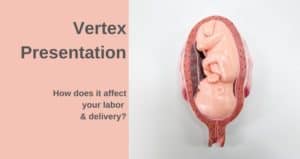



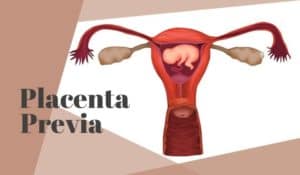

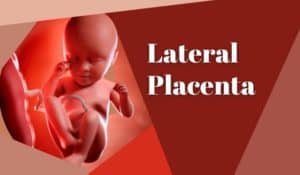



Some really excellent articles on this web site, appreciate it for contribution.